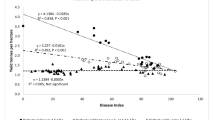Abstract
Field experiments were conducted during 2008–2009 and 2009–2010 to manage Alternaria blight of linseed caused by Alterneria lini and A. linicola integrated with Trichoderma viride, fungicides and plant extract. Seed treatment (ST) with T. viride (4 g/kg seed) followed by two foliar sprays (FS) of mancozeb (0.25 %) decreased the 56.16 % blight intensity and 55.64 % bud damage on mean basis with significantly lower mean blight intensity of 23.24 % and bud damage of 12.81 %, respectively. It also increased 56.70 % seed yield with higher 1,000-seed weight (Test weight) of 7.22 g and seed yield of 1,364.58 kg/ha. This treatment was found at par with the treatments ST with thiophanate methyl (2 g/kg seed) followed by 2 FS of mancozeb (0.25 %) and recommended practice i.e. ST with thiram (3 g/kg seed) followed by 3 FS of mancozeb (0.25 %). Maximum net return of Rs. 8,891.25 with benefit cost (B:C) ratio 5.51 was also recorded with same treatment against the net return of Rs. 8,395.00 with B:C ratio of 3.87, in case of recommended practice. Seed treatment with T. viride followed by 2 FS of garlic bulb extract (1 % w/v) or neem leaf extract (5 % w/v) were also found economical and gave net return of Rs. 5,710 and 4,166.62 with B:C ratio of 4.73 and 5.24, respectively.
Similar content being viewed by others
References
Srivastava RL (2010) Linseed: technology for increasing production, 3rd edn edn. Project Coordinating Unit (Linseed). C.S. Azad University of Agriculture and Technology, Kanpur, p 30
Anonymous (2010) Annual report: linseed: All India coordinated research project on linseed. Project Coordinating Unit C.S.A.U.A & T Campus, Kanpur
Singh RB, Singh AK, Srivastava RK (2003) Assessment of yield losses due to alternaria blight of linseed. J Oilseeds Res 20:168–169
Singh RB, Singh RN (2004) Management of alternaria blight of linseed. Ann Pl Prot Sci 12:305–309
Singh RB, Singh RN (2005) Occurrence, status and management of alternaria blight (Alternaria species) of linseed (Linum usitatissimum). Ind J Agric Sci 75:277–280
Singh J, Singh SK, Prakash O, Vajpeyi M (2006) Seed colour not a diagnostic character for disease resistance in linseed (Linum usitatissimum). Ind Phytopathol 59:180–184
Singh RB, Singh RN, Singh HK (2009) Evaluation of fungicides and genotypes for the management of alternaria blight (Alternaria species) of linseed (Linum usitatissimum L.). Proc Nat Acad Sci, India 79:410–414
Singh RB, Singh RN (2004) Occurrence and management of alternaria blight of linseed in eastern India. Pl Dis Res 19:120–124
Singh RB, Singh RN (2007) Integrated management of blight of linseed (Linum usitatissimum) caused by Alternaria species. Ind J Agric Sci 77:55–58
Singh R, Singh RB, Singh RN (2007) Spray schedule for the management of alternaria blight (Alternaria spp.) of linseed. Ind Phytopathol 60:494–499
Chand H, Singh S (2004) Effect of plant extract on alternaria blight of mustard. Ind J Pl Prot 32:143–144
Meena PD, Meena RL, Chattopadhyay C, Arvind Kumar (2004) Identification of critical stage for disease development and bio-control of alternaria blight of Indian mustard (Brassica juncea). J Phytopathol 152:204–209
Meena PD, Chattopadhyay C, Meena RL (2008) Eco-friendly management of alternaria blight in Brassica juncea. Ind Phytopathol 61:65–69
Chattopadhyay C (1999) Yield losses attributable to alternaria blight of sunflowers (Helianthus annuus L.) in India and some potentially effective control measures. Int J Pest Manag 45:15–21
Vadivel S, Ebenezar EG (2006) Eco-friendly management of leaf blight of tomato caused by Alternaria solani. J Mycol Pl Pathol 36:79–83
Mohan L, Rai PK (2007) Management of alternaria blight of senna (Cassia angustifolia) through fungicides and plant extracts. Ann Pl Prot Sci 15:165–169
*Mercer PC, Ruddock A, Mee E and Papadopolous S (1993) Biological control of alternaria disease of linseed and oilseed rape. In UK Bull OILB SROP 16(9):89–99
Ram D (1997) Fungitoxicity of some plant extracts against Alternaria brassicae. Ann Agric Biol Res 2:25–26
Acknowledgments
Authors are thankful to the Indian Council of Agricultural Research, New Delhi for financing the study under all India Coordinated Research Project on Linseed.
Author information
Authors and Affiliations
Corresponding author
Rights and permissions
About this article
Cite this article
Singh, R.B., Singh, H.K. & Parmar, A. Integrated Management of Alternaria Blight in Linseed. Proc. Natl. Acad. Sci., India, Sect. B Biol. Sci. 83, 465–469 (2013). https://doi.org/10.1007/s40011-012-0152-8
Received:
Revised:
Accepted:
Published:
Issue Date:
DOI: https://doi.org/10.1007/s40011-012-0152-8




